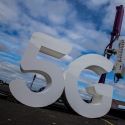
South Korea has the world's most extensive 5G rollout, so when the two big players appear in public, they have our attention.
Executives from SKT and KT shared some details of business and network performance at the 5G Asia conference in Singapore last week.
South Korea began the world's first nationwide 5G service with a simultaneous launch by all telcos on April 5.
For SK Telecom, the biggest positive since then is that it has halted the decline in revenue and average revenue per user (ARPU), according to Takki Yu, senior director and head of the access development team.
He said that, after falling in the previous seven quarters, ARPU had leveled off in Q2, though he acknowledged that it had not increased.
What has increased is data consumption. SKT's 5G customers are using 33.7GB a month, 65% more than LTE subscribers.
"5G users consume more and more data," Yu observed.
When it came to the take-up of new services, he had little to add, but said one of the main priorities was immersive media, including AR and VR.
He cited examples such as a mmWave 5G service connecting to a racing car, cloud gaming in partnership with Microsoft and smart office in collaboration with WeWork.
Yu said the network was performing at a higher level but running both 5G and LTE brings some complexity.
By aggregating 3.5GHz NR and LTE SKT has been able to reach typical speeds of between 1.5 Gbit/s and 1.8 Gbit/s, with top rates of up to 2.7 Gbit/s.
This will go higher next year when it deploys mmWave and should be able to deliver peak speeds of 7.2 Gbit/s, Yu said.
Next year SKT will also provide both standalone (SA) and non-standalone (NSA) 5G services.
But he said NSA operation was "very complicated because we need to operate it simultaneously with LTE."
Want to know more about 5G? Check out our dedicated 5G content channel here on
Light Reading.
For example, voice goes over LTE only because it is sensitive to delay and call drops, data is carried over 5G plus LTE, while low-latency services are 5G only. "You have to precisely control the operation of the network according to the type of service," he said.
Yu also acknowledged there a trade-off between data speed and latency. If you need some low-latency service, it meant a lower bandwidth.
But 5G service plans gave users flexibility in optimizing network performance according to requirements, he said.
He also highlighted the importance of mobile edge computing (MEC) for improving latency and said SKT was aiming to develop an open MEC platform with partners.
Apart from the network, SKT has built its own AI-driven OSS, Tango, for service assurance and customer care, and is using quantum tech for network security and authentication.
Yongmin Choi, a vice president for 5G core networks at KT, said that in rolling out 5G the priority was major transport routes as well as high population density areas.
KT has also deployed in 484 university campuses and six autonomous driving sites -- "one of the most promising new cases," said the executive.
He also alluded to performance differences between the various equipment vendors, without naming names.
Devices using vendor A achieved download speed of 1.126 Gbit/s and latency of 23.1 milliseconds, with vendor B delivering 920 Mbit/s and 39.7 milliseconds and vendor C managing 1.016 Gbit/s and 12.8 milliseconds.
Choi said average latency on the 5G network was 18 milliseconds and this could be reduced to 10 milliseconds using edge technology.
— Robert Clark, contributing editor, special to Light Reading
Read more about:
AsiaAbout the Author(s)
You May Also Like




_International_Software_Products.jpeg?width=300&auto=webp&quality=80&disable=upscale)







